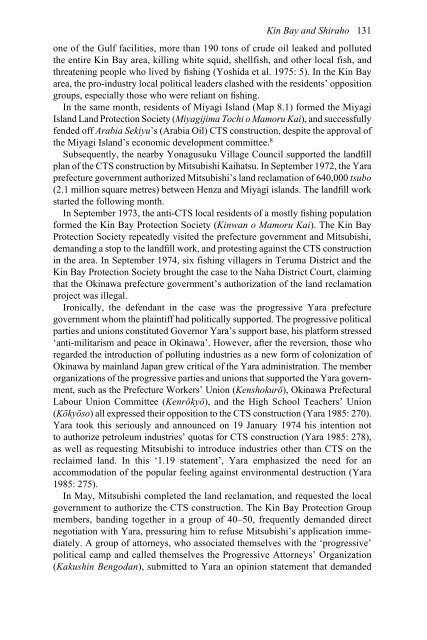Myth, Protest and Struggle in Okinawa
Myth, Protest and Struggle in Okinawa
Myth, Protest and Struggle in Okinawa
Create successful ePaper yourself
Turn your PDF publications into a flip-book with our unique Google optimized e-Paper software.
K<strong>in</strong> Bay <strong>and</strong> Shiraho 131<br />
one of the Gulf facilities, more than 190 tons of crude oil leaked <strong>and</strong> polluted<br />
the entire K<strong>in</strong> Bay area, kill<strong>in</strong>g white squid, shellfish, <strong>and</strong> other local fish, <strong>and</strong><br />
threaten<strong>in</strong>g people who lived by fish<strong>in</strong>g (Yoshida et al. 1975: 5). In the K<strong>in</strong> Bay<br />
area, the pro-<strong>in</strong>dustry local political leaders clashed with the residents’ opposition<br />
groups, especially those who were reliant on fish<strong>in</strong>g.<br />
In the same month, residents of Miyagi Isl<strong>and</strong> (Map 8.1) formed the Miyagi<br />
Isl<strong>and</strong> L<strong>and</strong> Protection Society (Miyagijima Tochi o Mamoru Kai), <strong>and</strong> successfully<br />
fended off Arabia Sekiyu’s (Arabia Oil) CTS construction, despite the approval of<br />
the Miyagi Isl<strong>and</strong>’s economic development committee. 8<br />
Subsequently, the nearby Yonagusuku Village Council supported the l<strong>and</strong>fill<br />
plan of the CTS construction by Mitsubishi Kaihatsu. In September 1972, the Yara<br />
prefecture government authorized Mitsubishi’s l<strong>and</strong> reclamation of 640,000 tsubo<br />
(2.1 million square metres) between Henza <strong>and</strong> Miyagi isl<strong>and</strong>s. The l<strong>and</strong>fill work<br />
started the follow<strong>in</strong>g month.<br />
In September 1973, the anti-CTS local residents of a mostly fish<strong>in</strong>g population<br />
formed the K<strong>in</strong> Bay Protection Society (K<strong>in</strong>wan o Mamoru Kai). The K<strong>in</strong> Bay<br />
Protection Society repeatedly visited the prefecture government <strong>and</strong> Mitsubishi,<br />
dem<strong>and</strong><strong>in</strong>g a stop to the l<strong>and</strong>fill work, <strong>and</strong> protest<strong>in</strong>g aga<strong>in</strong>st the CTS construction<br />
<strong>in</strong> the area. In September 1974, six fish<strong>in</strong>g villagers <strong>in</strong> Teruma District <strong>and</strong> the<br />
K<strong>in</strong> Bay Protection Society brought the case to the Naha District Court, claim<strong>in</strong>g<br />
that the Ok<strong>in</strong>awa prefecture government’s authorization of the l<strong>and</strong> reclamation<br />
project was illegal.<br />
Ironically, the defendant <strong>in</strong> the case was the progressive Yara prefecture<br />
government whom the pla<strong>in</strong>tiff had politically supported. The progressive political<br />
parties <strong>and</strong> unions constituted Governor Yara’s support base, his platform stressed<br />
‘anti-militarism <strong>and</strong> peace <strong>in</strong> Ok<strong>in</strong>awa’. However, after the reversion, those who<br />
regarded the <strong>in</strong>troduction of pollut<strong>in</strong>g <strong>in</strong>dustries as a new form of colonization of<br />
Ok<strong>in</strong>awa by ma<strong>in</strong>l<strong>and</strong> Japan grew critical of the Yara adm<strong>in</strong>istration. The member<br />
organizations of the progressive parties <strong>and</strong> unions that supported the Yara government,<br />
such as the Prefecture Workers’ Union (Kenshokurō), Ok<strong>in</strong>awa Prefectural<br />
Labour Union Committee (Kenrōkyō), <strong>and</strong> the High School Teachers’ Union<br />
(Kōkyōso) all expressed their opposition to the CTS construction (Yara 1985: 270).<br />
Yara took this seriously <strong>and</strong> announced on 19 January 1974 his <strong>in</strong>tention not<br />
to authorize petroleum <strong>in</strong>dustries’ quotas for CTS construction (Yara 1985: 278),<br />
as well as request<strong>in</strong>g Mitsubishi to <strong>in</strong>troduce <strong>in</strong>dustries other than CTS on the<br />
reclaimed l<strong>and</strong>. In this ‘1.19 statement’, Yara emphasized the need for an<br />
accommodation of the popular feel<strong>in</strong>g aga<strong>in</strong>st environmental destruction (Yara<br />
1985: 275).<br />
In May, Mitsubishi completed the l<strong>and</strong> reclamation, <strong>and</strong> requested the local<br />
government to authorize the CTS construction. The K<strong>in</strong> Bay Protection Group<br />
members, b<strong>and</strong><strong>in</strong>g together <strong>in</strong> a group of 40–50, frequently dem<strong>and</strong>ed direct<br />
negotiation with Yara, pressur<strong>in</strong>g him to refuse Mitsubishi’s application immediately.<br />
A group of attorneys, who associated themselves with the ‘progressive’<br />
political camp <strong>and</strong> called themselves the Progressive Attorneys’ Organization<br />
(Kakush<strong>in</strong> Bengodan), submitted to Yara an op<strong>in</strong>ion statement that dem<strong>and</strong>ed
















